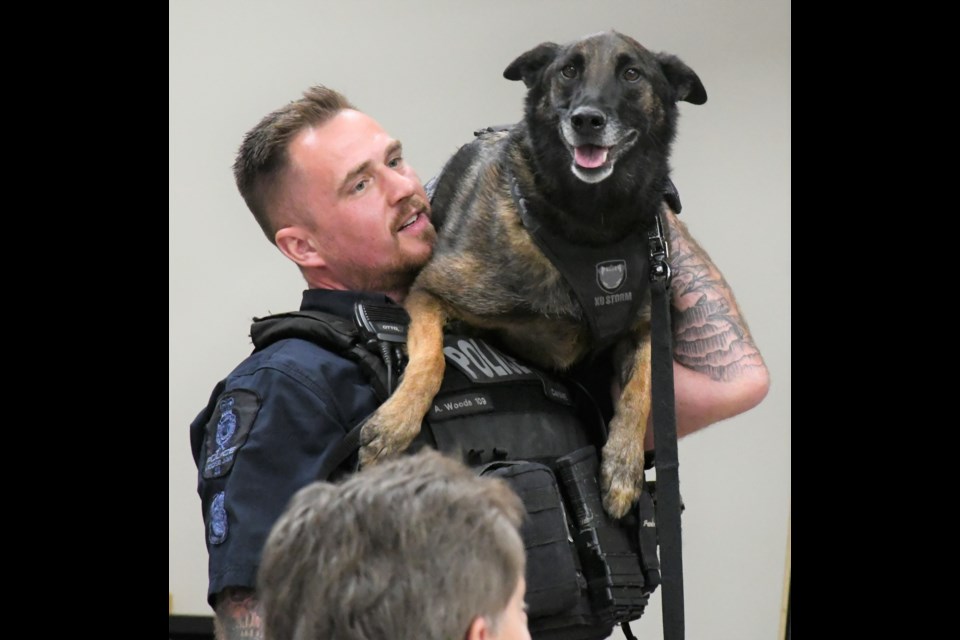Moose Jaw’s Board of Police Commissioners gained a better understanding of the Moose Jaw Police Service’s K-9 Unit thanks to a presentation that included an excited — but well-trained — Belgian Malinois puppy.
Const. Aaron Woods spoke to the board during its May 19 meeting while accompanied by his four-year-old partner, True. The K-9 Unit has existed since 2007 and has four teams. Woods — who has been with the police service for 12 years — and True have been a team since March 2019.
“We like Belgian Malinoises just because they’re durable, they’re fast, they’re smart … they’re hard workers … they love people. They’re great police dogs,” Woods said.
He trains True at least one hour a day while on shift, including practising tracking down people or evidence; she could be trained in the future to find drugs. Moreover, the entire unit trains together once a month; police dogs need at least 90 minutes per day of exercise.
“We never stop training. It’s probably 99 per cent of what we do,” the constable said.
At home, he teaches her to fetch and obey commands while also playing fun games. The only downtime True receives is in a large outside pen when he is away from home.
“She’s my shadow,” Woods added.
Successful finds
The K-9 Unit works with other officers on general patrol — and will support the forthcoming tactical/SWAT team — and responds to various calls for service, Woods explained. True “is a fantastic tracker” and has successfully found almost everyone she has tracked.
One of the duo’s biggest accomplishments “under our collar” was tracking down a murder suspect a few years ago, he continued.
It was 11:30 p.m. on a minus 35-degree Celsius night and a police dog was needed to track a suspect. Woods and True arrived an hour after the call and began searching for the individual. The pup found the track immediately and practically pulled the officer down the street. They ended up at the back door of a home and arrested the suspect.
“Without True, we likely would have found our guy, but it would have been a long time later. We would have lost a lot of very critical evidence (and) critical information,” said Woods.
Another successful find for True was tracking a suicidal woman when it was -40 C at night. Thanks to the dog’s “incredible” sense of smell, Woods found the hypothermic woman lying in a field. He noted that saving the woman’s life — and lives in general — was one reason he joined the K-9 Unit.
“(True is) my best friend, my best buddy,” Woods said. “… She’s hanging out in the truck, usually bopping my arm every 20 minutes, ‘What are we doing? I’m bored. Let’s go. Let’s do something.’ She wants to work, she wants to get out, she wants to do stuff.”
Selection process
After applying to join the K-9 Unit, the police service put Woods through a battery of tests to see if he was worthy. This included an interview, psychological assessment, physical exam, and tactical understanding.
The physical test was “horrible,” he said. It occurred at Guthridge Field, where he had to run a lap around the track while in full uniform, pick up an 80-pound sack, toss it over the fence, climb over the fence, and then toss the sack back over.
He had to repeat this process four times.
“They don’t care how long it takes you to do it. It’s if you can grind it out then and embrace the suck, basically,” said Woods.
Meanwhile, when True was eight weeks old, her breeder identified that she was a candidate to be a police dog because of the attributes — a work ethic and good nose — she displayed. The breeder contacted the police station and recommended the purebred pup for the K-9 Unit.
The cost to purchase a dog for police work is $7,000 to $10,000.
After being teamed together, Woods and True participated in a 600-hour training course.
Longevity
Some Belgian Malinois police dogs have been known to work until 11 years old, which is one reason the officers like using them, Woods said. Once True retires, he could purchase her from the police service — he would pay all future food and vet bills — and keep her as a pet.
Woods joked that his wife and kids would never forgive him if he didn’t adopt True after retirement because they love the pup so much.
The next Board of Police Commissioners meeting is Thursday, June 9.




